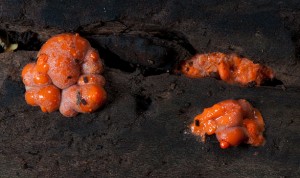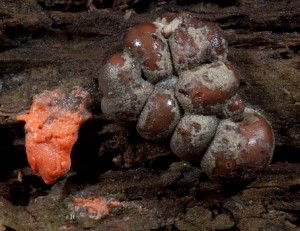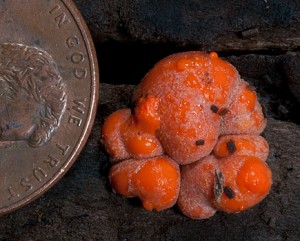Slime Molds are bizarre life forms that were classified as fungus but are now placed in their own kingdom. At one time, every living thing was placed in either the plant or animal kingdom. Currently, most scientists recognize six kingdoms: Plants, Animals, Protists (slime molds and algae), Fungi, Archaebacteria (bacteria found mainly in thermal vents), and Eubacteria; the remaining bacteria.
Slime molds belong in the phylum Myxomycota. John Tyler Bonner writes, “[Myxomycetes are] no more than a bag of amoebae encased in a thin slime sheath, yet they manage to have various behaviors that are equal to those of animals who possess muscles and nerves with ganglia—that is, simple brains.”
The life cycle is complex. An over simplified description of the life cycle is that the spores develop into single cell organisms that then congregate into a fruiting mass producing spores. (If you desire a technical description of the life cycle see the UBC Botanical Garden Website)
Wolf’s Milk Slime Mold (Lycogala epidendrum) is also called Toothpaste Slime Mold. It is circumpolar in the northern hemisphere, ranging throughout Michigan. The fruiting bodies congregate on logs (epidendrum means growing on logs), normally in the fall in Michigan. This is a slow moving slime mold taking days to change shape.
The small size of this slime mold makes it easy to overlook but its bright orange color draws your eye. It is easy to mistake this slime mold for a developing fungus of some kind. After a few days this bright orange color becomes chocolate brown and the slime mold disperses spores. Get out and look for it before the days get too cold.



